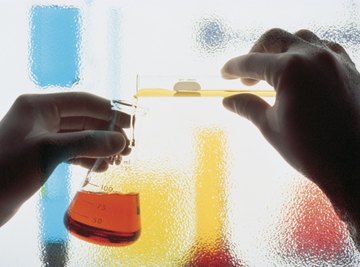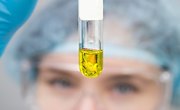
When you mix two or more substances with different levels of concentration, the final solution does not simply equate to the combined concentration levels of the original ingredients. The nature of the experiment drives the ingredients used, including their individual concentration levels. Concentration levels typically represent a percent of the original ingredient by volume of the container, because there are no set units of concentration.
For example, if you mix 100 ml of a 10 percent concentration of compound A with 250 ml of a 20 percent concentration of the same compound, a mathematical formula involving the initial concentrations of the two solutions, as well as the volume of the final solution, allows you to work out the final concentration in percent of the volume of the new combined solution.
You can use any units you wish for the concentration values and volumes, so long as you use the same units for each of the two solutions. Concentration can also be expressed by percent composition by mass, mole fraction, molarity, molality or normality.
For example, work out the percent composition by mass of a 100 g salt solution containing 20 g salt by dividing the mass of the concentration by the total mass of the solute, then multiplying it by 100. The formula: (20 g ÷ 100g) x 100, which is 20 percent.
If you don't know the concentrations of your initial solutions, calculate molarity by dividing the number of moles in a solute by the volume of the solution in liters. For example, the molarity of a 0.6 moles of NaCl dissolved in 0.45 liters is 1.33 M (0.6 mol ÷ 0.45 L). Do this for both substances to let you calculate the final concentration of the solution. (Remember 1.33 M stands for 1.33 mol/L and not 1.3 moles.)
Determine the volume of each concentrated substance used in the experiment, by converting the concentration percentage to a decimal (i.e. dividing by 100) and then multiplying by the total volume of the solution. The calculation for the volume of compound A in the first concentration is (10 ÷ 100) x 100 ml, which is 10 ml. The calculation for the volume of compound A in the second concentration is (20 ÷ 100) x 250 ml, which is 50 ml.
Add these amounts together to find the total amount of compound A in the final mixture: 10 ml + 50 ml = 60 ml.
Add the two volumes together to determine the total volume of the final mixture: 100 ml + 250 ml = 350 ml.
Use the formula x = (c ÷ V) × 100 to convert the concentration (c) and volume (V) of the final solution to a percentage.
In the example, c = 60 ml and V = 350 ml. Solve the above formula for x, which is the percentage concentration of the final solution. In this case, x = (60 ml ÷ 350 ml) × 100, so x = 17.14 percent, meaning the final concentration of the solution is 17.14 percent.
Tips
References
About the Author
Claire is a writer and editor with 18 years' experience. She writes about science and health for a range of digital publications, including Reader's Digest, HealthCentral, Vice and Zocdoc.
Photo Credits
Comstock/Comstock/Getty Images
